Producer and/or sound engineer for MANU CHAO, FEIST, GONZALES, JAMIE LIDELL, MOCKY, PEACHES, JANE BIRKIN, SEU JORGE .
The first time we saw him in 1993 on the cover of Alain Souchon's album "C'est dejà ça" (almost two million copies), Renaud Letang really looked like a kid. But in fact he already had a lot of good work behind him.
At the age of 23, he had already worked with Phil Ramone at the Guillaume Tell studio in Suresnes (near Paris), on soundtracks or with Jean-Michel Jarre. He began his ten year collaboration with Jarre on July 14, 1990 at Paris-La defense, in front of two and a half million people as front house sound engineer. Then followed, among others, London (Wembley) and Moscow, to end at the Pyramids of Gizeh in Egypt on 31 dec, 1999.
Here and there, Renaud Letang learned what others knew before him but what is always worth being reminded of : the tool is not the language, the technique is a means not an end. Since then, preferring the emotional approach to the intellectual, Renaud Letang has become one of the most esteemed producers and sound engineers in France.
Up to today, Renaud's most well known work was done for Feist, Manu Chao or Alain Souchon, to mention but a few. His work ranges from pop to hip-hop : Peaches' Album Fatherfucker ( 2003), Jamie Lidell's Multiply (2005), Seu Jorge's Cru (2004) or his remixes for Mocky or Bjork with the Canadian Artist Gonzales (under the name VV).
Working with Gonzales since "Presidential Suite III" (Gonzales, 2002) their sparse orchestrations have pleased and traveled all the way to the United States, with the disco-pop-folk album "Let it die" (2004) by the Canadian Feist.
For Jane Birkin, the Frenchiest of English women, in her album "Rendez-Vous" (2004), Renaud Letang and Gonzales repeated that same kind of minimalist style, leaving breathing space for the sound, allowing the texts and melodies their rightful place and the many vocal facets of the duets to bloom. With Beth Gibbons, Bryan Ferry, Caetano Veloso and a few other names of the French and Japanese music scene, Jane Birkin found a new freedom with this repertoire, that her status as a gainsbourian icon couldn't really allow her anymore.
This is just one of the many examples demonstrating the work of this duo formed by a producer and a multi instrumentalist agreeing on arrangements with fewer notes but the right ones.
Renaud Letang engineered two studio albums and two live ones for Alain Souchon, and one of them "Defoule Sentimentale" (1996) won Renaud the "Victoires de la musique" award as sound engineer. Alain Souchon said of Renaud : "His talent is that he will never be the slave of his musical inheritance". Another French artist, Mathieu Boogaerts, said about Renaud. "He's the first professional in whom I recognized myself. The first time I met him, I thought he could be one of my school friends; same size, same clothes, same wish to keep our teenage dreams intact. The notion of taking pleasure in his work is most important for him. His mixes are made in a way that you want to hear them again and again".
Many surprises came with the experience of working with Manu Chao. When Manu's group, La Mano Negra dissolved after its tour in Colombia, Manu wanted to make an electronic album for his first solo project. Renaud and Manu met for the first time in a café in Sèvres, a suburb of Paris and soon began to work on that album. But one day, the software wouldn't open. Accidents can sometimes open new perspectives and the techno project became in fact the intimate best-seller we know as "Clandestino". Renaud Letang keeps saying that this recording made in different places around the world, on a desk that fitted in a back-pack, helped him become more confident and revealed things to him that he never thought of. "With this record, I've realized that the angle, i.e, the point of view, modifies the proposal, and that often good things appear by accident".
Son of an engineer, Renaud Letang was born in Teheran under the Shah. He lived in Indonesia (Djakarta) then in Venezuela (Caracas) where favelas touch residential neighborhoods. There, he learned to play the piano and love Art Tatum like his Dad did. But it was in France, during his teenage years that he played guitar in his first rock band. We still find guitar, keyboards, vinyls, turntables and many other instruments in the big underground room he uses as a laboratory at the Studio Ferber. It's there, on the east side of Paris, that Renaud Letang locks himself in all year long, his head in the diodes like in a microwave oven. He seeks the sound that will hook someone somewhere. He tries to reduce the distance between the fingers of the musician and the ear of the melomane. Renaud Letang recreates and reinvents everyday an art close to telepathy.
